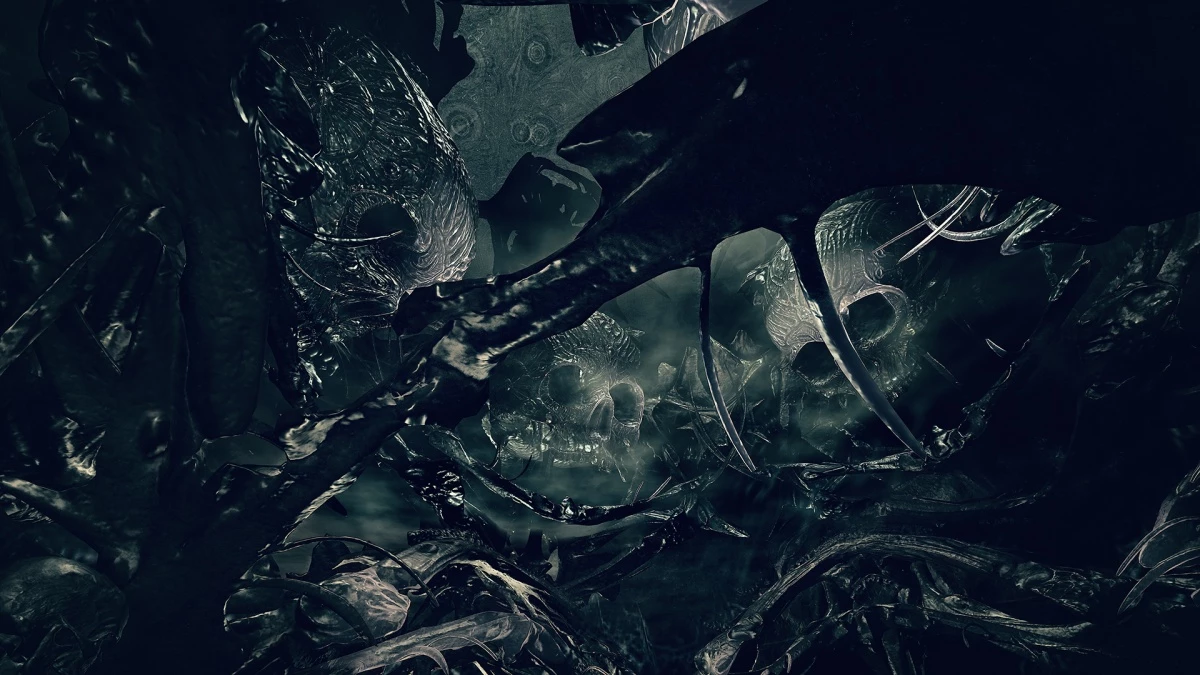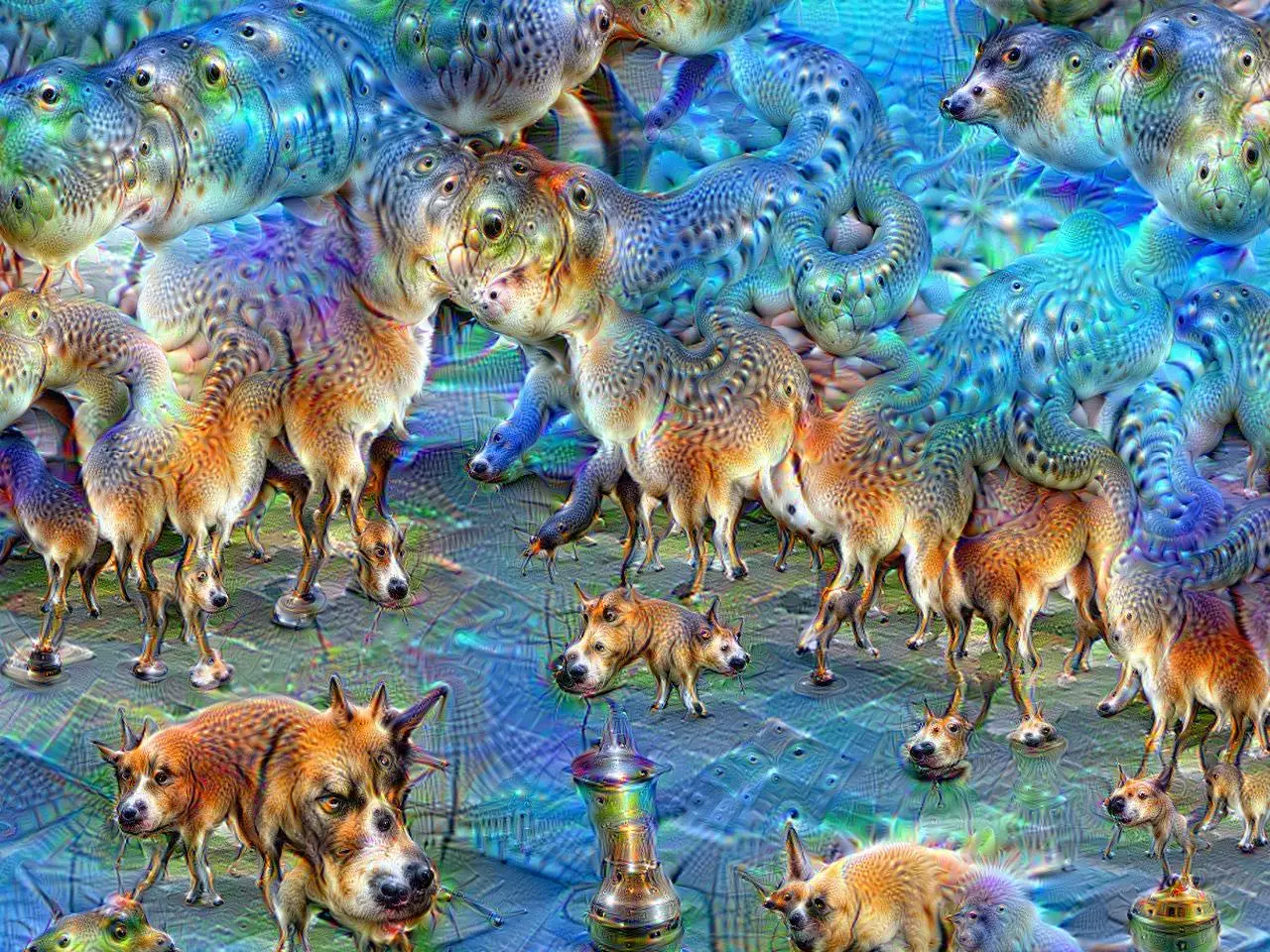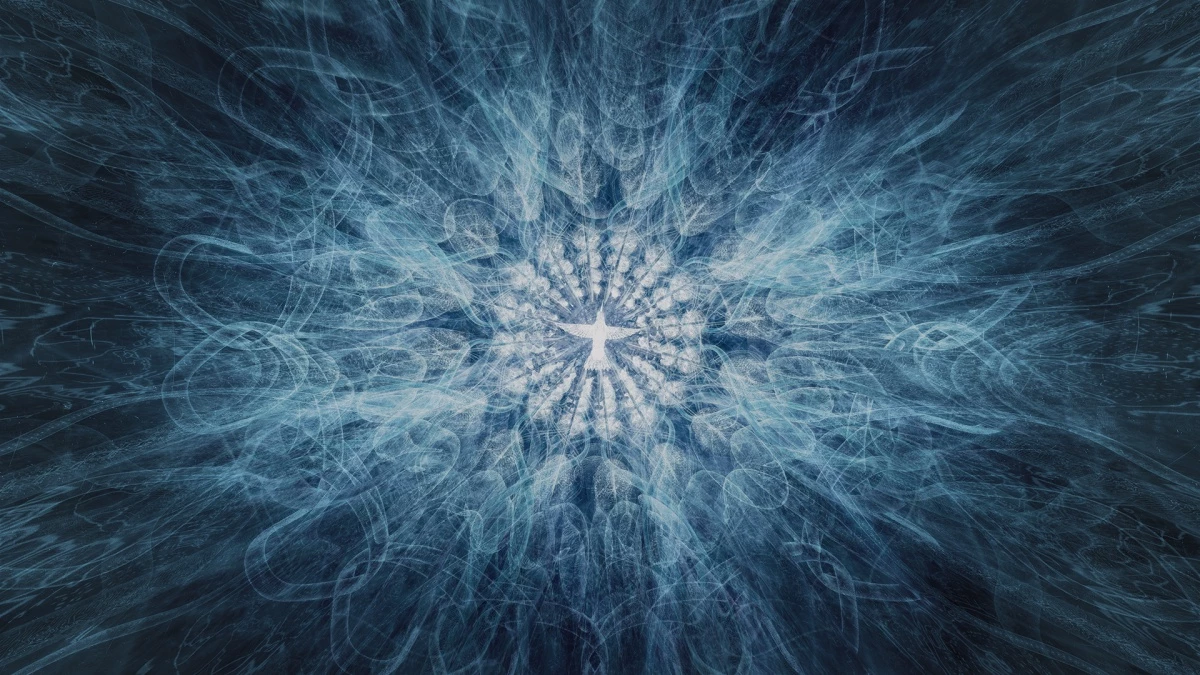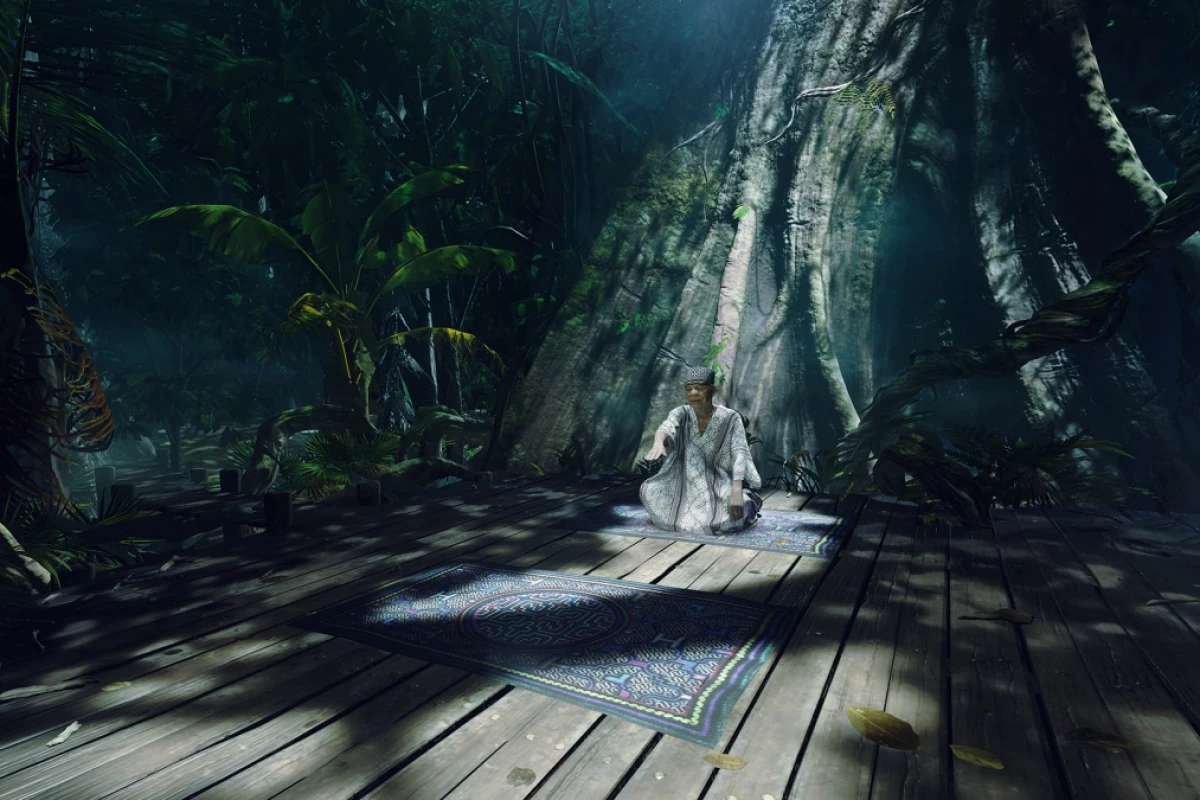A few weeks ago I experienced a virtual reality ayahuasca trip. Unlike a real ayahuasca experience I did not travel to the Amazon, spend hours vomiting, or experience any kind of ego-dissolving transcendental moment. Instead, I slipped on a VR headset and saw some pretty pictures swirl around me for about 12 minutes.
The VR experience is called Ayahuasca (Kosmik Journey), and it was created by Jan Kounen, a French filmmaker who has been fascinated by this hallucinogenic shamanic experience for over 15 years. Kounen first attempted a cinematic depiction of an ayahuasca experience in his 2004 western Renegade (aka Blueberry). Since then he has penned several books on the subject, and directed a documentary about shamanism.
It is perhaps unsurprising that Kounen continued his artistic quest in psychedelic depictions by creating an ayahuasca VR experience. But, however visually accurate the VR experience is purported to be, it feels like a fundamentally superficial exploit, turning a profoundly sublime and life-changing psychedelic experience into an empty spectacle of visual effects that quickly becomes remarkably dull.
“Taking ayahuasca is not for everyone,” Kounen recently said in an interview with ArtsHub about his VR experience, “it’s a strong experience that will be good for some and too much for others. So this is a safe way to see how the plant works. Of course, it’s not the real thing – that is much stronger and you can’t escape by taking off the helmet!”
I didn't like Ayahuasca (Kosmik Journey). It felt lazy, simplistic, but most of all, dull. Kounen’s ayahuasca VR experience did however raise some questions. Can a profound altered state of consciousness be induced by a piece of art? Can the line between depicting a psychedelic experience, and inducing one, actually be crossed by a multimedia experience? Or is it futile to even try?
The limits of film
“To me, I think parts of films like Enter The Void, 2001, and some experimental works, such as Inauguration of the Pleasure Dome and Allures may get closest to inducing an altered state in viewers who are not on drugs – but then again, other parts of these same films may seem interminable to sober viewers as well.”
Indiana University film scholar David Church has investigated the intersection between cinema and psychedelic drugs. He suggests that some experimental works from the 1960s, such as a stroboscopic flicker device from Brion Gysin, can certainly function to induce mild hallucinations, but there may be limits to what kinds of experiences audio-visual works can generate in the absence of pharmacological substances.
“One of the problems with using films to try to “induce” a psychedelic state without the addition of drugs within the viewer would seem to be that different viewers’ psychologies may be more susceptible to entering such states than others (much as some people are more easily hypnotized than others, for example), and the duration of the psychedelic sequences in most films is not ideal for syncing up with attempts to “trip,” with or without drugs,” says Church.
Ultimately, Church is reasonably skeptical a multi-media experience can induce a kind of experiential consciousness-altering state without there being at least some pharmacological element present. Although Church does still see value in the mere act of depiction, even if the sequences fall short of conveying the embodied effect of a drug high.

Visionarium
Visionarium is another VR experience explicitly referencing the journey of an ayahuasca trip. Artist Sander Bos is well aware of the limitations inherent to VR technology but he still believes there is value in offering a simulation of a psychedelic experience. Bos also believes the immersive nature of VR can generate physical effects, even though the medium doesn’t directly influence brain chemistry in the same way as a psychedelic drug.
“If we can make the mind believe it’s really in this other place it can physically effect you,” Bos tells New Atlas. “I’ve had friends who I put into the Visionarium experience who said it’s very similar to an ayahuasca ceremony, you get the same belly tingling, sweaty palms, feeling of weightlessness and losing sense of the body. I do not think, however, that the technology we have at the moment can go as deep as a real psychedelic experience, because the real thing includes you, your dreams, fears, hopes, imaginations and the opening up to your own infinite potential as a human being or looking into your very own mysterious soul. It is an integral part of the experience.”
Cyberdelics
Jon Weinel, a London-based artist and writer, compellingly explored how music and audio-visual media functions to bring about transformative affective experiences in his 2018 book Inner Sound. Weinel particularly investigated how some virtual reality experiences try to induce a type of altered state of consciousness (ASC), but he specifically notes, we need to broaden our definition of what an ASC actually is.
“So ASCs can include hallucinations, meditation, trance or even dreaming – psychedelic experiences are only one type,” Weinel tells us. “I think most of the VR experiences that aim to induce an altered state are not necessarily trying to exactly replicate the same state that psychedelics do. If you want that you could go and take psychedelics. What is interesting I think is that people are inspired by the idea of psychedelics as providing transformative experiences, and so are seeking to provide VR or media-art experiences that might be provocative in some way for the person experiencing it.”
Weinel's research brings up a fascinating alternative movement blending counter-culture psychedelia with cutting-edge immersive technologies. The movement has been dubbed "cyberdelics", and it has existed in various forms since the 1960s, when hippies used primitive audio-visual techniques to try and enhance their psychedelic drug experiences.
In the 1990s, iconic counter-culture figure Timothy Leary became somewhat enamored with the fusion of psychedelic culture and digital technology, not only appropriating his classic saying "Turn on, tune in, drop out" into "Turn on, boot up, jack in," but going as far as hyperbolically suggesting, "PC is the LSD of the 90s."
While the cyberpunk shenanigans of 1990s technoshamans now seem hilariously outdated, modern cyberdelic practitioners are relishing current digital technologies, creating compelling immersive experiences that are mostly not trying to explicitly copy the experience of taking psychedelic drugs, but rather induce a novel kind of physical sensation distinct to the technology.
“The general idea of ‘cyberdelics’ is usually less about replicating the psychedelic experience that is produced by drugs – it’s more about recognizing that technology may be capable of producing 'mind manifesting’ effects in some unique ways,” explains Weinel. “I think this movement is interesting because people are exploring how media and technology could have transformative affective properties … and although not all ‘cyberdelic’ experiences necessarily hit the mark, the general idea is to provide affective media experiences that may have a positive effect on the individual.”

Reflecting on my own ayahuasca VR experience, perhaps my problem with the project stemmed from its obsession with replicating a traditional cultural ceremony, instead of trying to focus on the novel effects of the VR technology itself. Ayahuasca (Kosmik Journey) quite literally begins with the participant sitting on a rug, deep in the Amazon jungle, in front of an old, stereotypical shaman.
Kounan’s somewhat myopic focus on so explicitly depicting a certain ancient, geographically specific, experience ultimately feels like an unsettlingly thorough act of cultural appropriation, taking a rich and distinct traditional ceremony and turning it into a short “trippy” spectacle, easily consumable for Western audiences. It's the psychedelic equivalent of a theme-park ride for curious urban hipsters.
Ayahuasca (Kosmik Journey) is a sanitized and palatable version of something deeply spiritual and meaningful, and while the VR experience has undeniably been created with sincere intent, it still can’t help but come across as a textbook form of 21st century technological colonialism.
But, maybe the meshing of a psychedelic experience with virtual reality is not fundamentally futile, maybe it just needs to home in more specifically on the novel strengths of the technology. Instead of trying to so literally recreate an LSD or ayahuasca experience, maybe technologically-mediated ASCs need to find a language wholly its own.
The Deep Dream trip

Back in 2015, Google engineer Alexander Mordvintsev unleashed a hallucinogenic nightmare on the world called Deep Dream. The now iconic neural network was a little like a facial recognition system in reverse, offering a fascinating insight into how computers “see” images, and delivering a torrent of stunningly psychedelic images to fuel the internet’s nightmares. In many ways Deep Dream achieved a profoundly true, yet wholly unique, definition of the term psychedelic.
After all, the word psychedelic is a blend of two Greek words – "psyche", meaning 'mind", and "delos", meaning "manifesting". Hence, the word psychedelic is often synonymous with the term "mind-manifesting". Deep Dream visions offered a truly disorientating insight into how a computer algorithm sees the world. These visions may not be exactly the same as manifestations of a human mind, but they are inarguably manifestations of some kind of alien perception. A truly modern technological vision of the world.
A team of researchers from the University of Sussex wondered what would happen if they combined panoramic Deep Dream images with a 360-degree virtual reality headset. The result was dubbed the Hallucination Machine.
Instead of explicitly trying to replicate a subjective psychedelic experience, the Hallucination Machine utilized state-of-the-art technologies to generate a unique hallucinatory experience. In a study published in the journal Scientific Reports, the researchers qualitatively compared experiences elicited by the machine, to those reported by users taking the psychedelic drug psilocybin.
“Using an altered states of consciousness questionnaire, we compared the subjective rating after experiencing the Hallucination Machine with the experience after taking a psychedelic,” Keisuke Suzuki, an author on the research tells New Atlas. “We found there are several similarities between the two experiences, which suggests that the Hallucination Machine can indeed simulate a certain aspect of the psychedelic state.”
Suzuki is clear that his team’s work with the Hallucination Machine only specifically focuses on visual hallucinations, and is not geared to simulating the psychedelic experience as a whole. He sees the limited nature of VR as quite valuable in enabling study of specific psychedelic characteristics, such as visual hallucinations, without other sensory disruptions, such as temporal distortions.
Suzuki does however suggest we may, at some point in the future, find effective technological ways to generate some of the more abstruse aspects of psychedelic experiences. Currently, VR is only really good at mimicking external sensory inputs (visual, auditory, tactile) but Suzuki believes incorporating other physiological techniques may bring us closer to something equivalent to a pharmacological psychedelic experience.
“For more radical experiences such as ego-dissolutions or the sense of unity, we still don’t have any clues how to simulate them with VR for the moment, but I believe manipulations of body may be a key for approaching distortions of self-consciousness in general,” Suzuki hypothesizes. “To fully simulate altered states of consciousness, we might need to combine VR technologies with real-time neuronal/physiological feedback techniques (e.g. brain-machine interfaces). But it will still take some time and effort to reach the level of what pharmacological substances can do.”

Suzuki and Weinel's contention that VR technology offers media experiences that can’t exactly simulate pharmacological psychedelic experiences but deliver novel sensations unique to the medium seems key to my own frustrations with Kounan’s ayahuasca work. Many VR practitioners may see the medium as a tool for merely replicating conventional real-world experiences. Riding a rollercoaster, standing on an African plain amidst a pride of lions, or even taking an ayahuasca trip – but on your couch at home.
Instead, maybe we need a new paradigm for VR in general, and VR psychedelia more specifically. We don’t need to try to create a 12-minute VR simulacrum of an Amazonian psychedelic experience. A true VR psychedelic, or cyberdelic, experience must be one that embraces the fundamental nature of the technology, while recognizing the medium’s limitations. Virtual reality may be able to superficially recreate certain human experiences, but we are still yet to uncover the true potential of the medium. As Jon Weinel suggests, just as "music is capable of inducing high energy ‘trance’ states through rhythm," we are only now discovering what kind of altered states of consciousness VR can induce.




